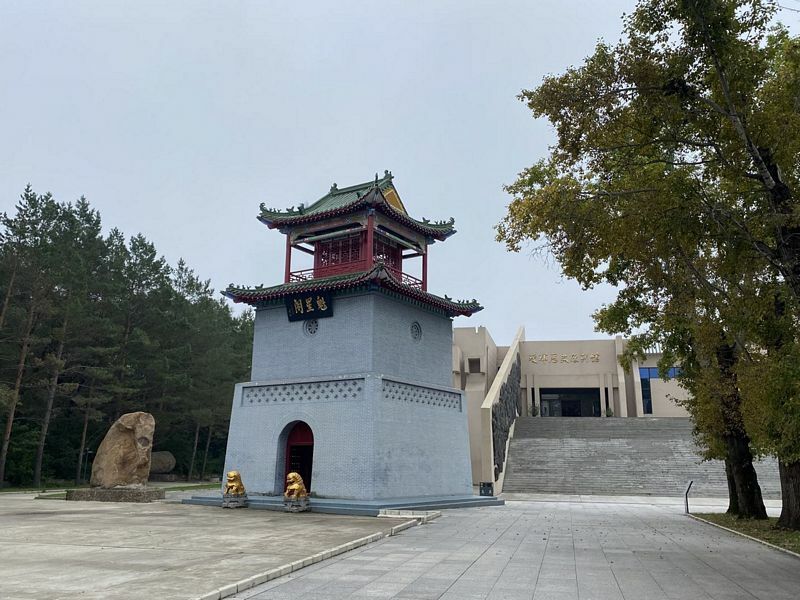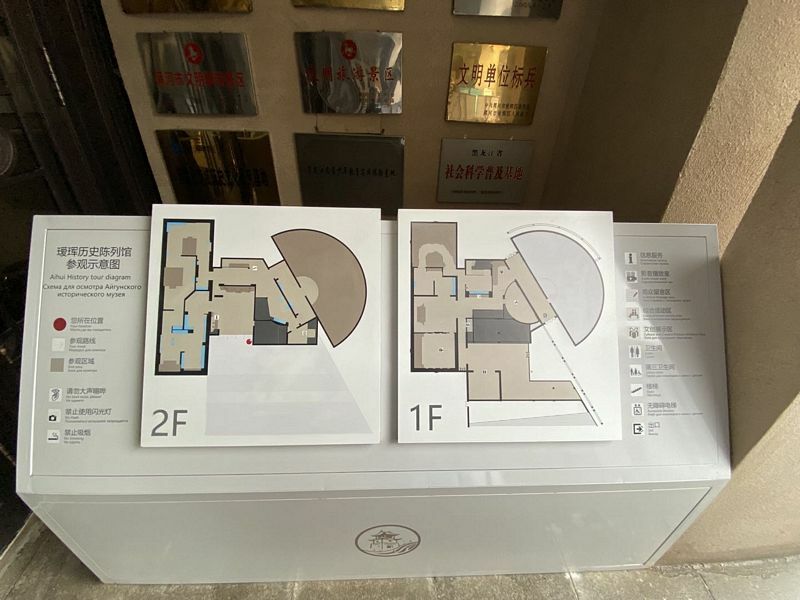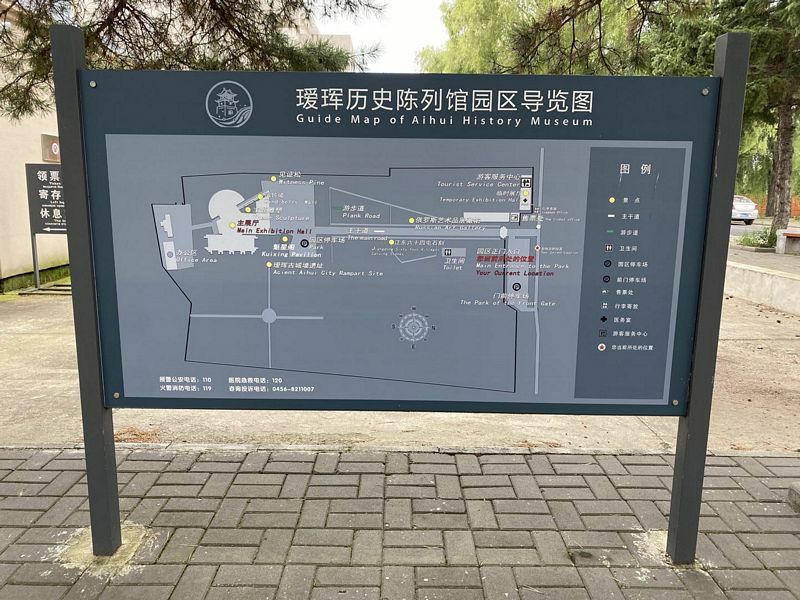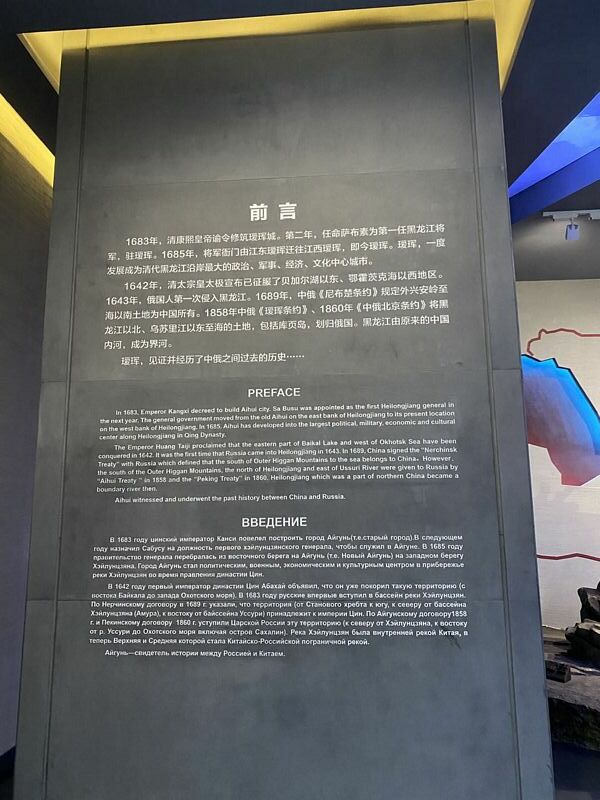Russians not allowed!
Aihui History Museum

In the far north of Heilongjiang Province, the most northerly region of China, a mighty river snakes along what is now the border between the People’s Republic of China and the Russian Federation. To Chinese this is known as the Heilongjiang (the ‘Black Dragon River’, which gives its name to the entire province), and to Russians this is the Amur. It seems like a logical boundary these days, but this was not always how the territory of north east Asia was divided up, and it is the story of this boundary that is examined and explained in the fascinating Aihui History Museum – but foreign visitors may have to navigate a bewildering array of racism, illogical rules, and general silliness to make a visit here (at the time of writing, August 2021).
Aihui is now a small town, around 45 minutes’ drive from the city of Heihe which sits on the river directly opposite the Russian city of Blagoveshchensk. These comparable-in-size (each home to around 415,000 people) used to feature constant flows of folks moving back and forth across the river for visiting and trade, but this has completely dried up since the advent of Covid19, with multiple people telling me in Heihe (where literally hundreds of Russians per day would visit, plus those who lived and worked in the city), that I was the first white person they had seen in nearly two years.
While Heihe and the area directly around it are clearly quite keen on the Russian presence, with street signs and business signs often to be found in Russian as well as Chinese, as well as holiday camps and other tourism infrastructure designed for the needs of the neighbours, the town of Aihui, or at least its main museum, is diametrically opposed to this sensible position. In fact the Aihui History Museum literally bans Russians from visiting.
Why is this? We have to look to history, and the exact history described in the museum itself, which means that for Any Russians who want to find out why they are banned then they would have to send in a non-Russian buddy to find out, an absurd, offensive, and utterly stupid policy obviously.
Back in the day, by which I mean prior to the mid-17th Century, much of the land which makes up the far east of Russia was actually Chinese, or at least under the official control of the Qing Dynasty (the degree to which direct control was actually enforced on the mostly-non-Chinese populations is a matter of some controversy and debate, I’m not getting into that here!). Russia was a rising power with a hunger for the lands of the east and the collapse of the Ming Dynasty had weakened Chinese control of this part of the world and so Russian advance parties (not just military units, but also traders and various wealth-seekers) moved in and made various claims, bringing them into conflict with Qing authorities who were attempting to consolidate their control over the lands they had taken from the previous regime.

The 1689 Treaty of Nerchinsk gave up Russian claims to the area north of the Amur/Heilongjiang River but opened some Chinese markets to Russian goods as well as a flow of luxuries in the other direction. This seemed equitable to all parties but two hundred years later the situation had changed greatly and Qing China was past its prime while Russia was growing hungrier and unilaterally decided that the reality f the age meant that the previously ceded lands should actually become part of the Tsar’s Empire.
The Treaty of Aigun (Aigun is Aihui, an old name for the same place - actually one is old Chinese, one is Manchu. It is called Aigun in Chinese these days though) granted these lands to Russia, but of course this was not as peaceful as it may sound as at the time (the treaty was signed in 1858) China had been struggling with the vast and bloody Taiping Rebellion (led by Jesus’ Chinese brother) as well as losing the Second Opium War so this was a landgrab by an opportunistic power without doubt.
To make things worse for China Russia was now emboldened and just twenty years later at the Convention of Peking decided to have what is now Primorsky Krai – the far eastern part of Russia that leads down to Vladivostok and the border with North Korea – too. Again, China could do nothing about it as the Qing Dynasty was nearly on its last legs by this time and various foreign powers had taken to carving bits of the country for themselves.
In 1900 the Russians even moved across the river and seized Aigun itself. At this time the anti-foreigner Boxer Uprising (usually called the Boxer Rebellion, but as it was aimed against what were seen as invaders then Uprising is surely the more accurate term). Aihui History Museum is quite graphic on what occurred next – a massacre of the local population, utter annihilation of multiple surrounding villages, mass murder of civilians as well as fighting men, and general nastiness leading to a poisoning of the already-bad relations between the two sides.
Russia remained in control of Aigun (as well as much of Heilongjiang itself, see much of the architecture of central Harbin for evidence of this) for several years, but the loss to Japan in the Russo-Japanese War (1904-05) led to a slow retreat and ceding of the status of regional power to the rising power of the rising sun (what happened from this point most students of history already know – Japan’s dominance and control of the region until World War II, the collapse of the Tsarist system in Russia in a string of Revolutions, The end of the Qing, the brief existence of the Manchurian Puppet state, the victory of the Chinese Communist Party int eh civil wars of China, and so on).
It’s all complicated and also fascinating. As usual though it is bloody, nasty, and has countless innocent victims who would of course have traded being part of something fascinating for not being killed or ruined by that very fascinating event.
Also, I had to look a load of this information up despite it being on display (in three languages; Chinese, English, Russian), in the excellent Aihui History Museum – why didn’t I just record it at the time? Well because photos are not allowed in that museum, and why are they not allowed? Let’s go back to the start of my visit to this both amazing and annoying place!
Driving from Heihe through a lovely landscape of sunflower fields, forests, and small villages I was stopped by the local police – in plainclothes, and without initially showing any identification (only when challenged). They were nice and polite enough, but when I asked why they stopped me they said it was because a foreigner was driving through their town. I asked how they knew I was a foreigner and they just laughed. I pointed out that they had stopped me for being white rather than being a foreigner as this is the only identifying factor they had, and they said this was exactly the case – glad to have that cleared up then! Anyway, they accepted my reason for being in their town, were glad that I wasn’t spreading any virus, and let me go on my way. All harmless enough.

On arrival at the museum, I was asked by a security guard at the entrance what country I was from. A common enough question in China, especially outside of the major cities. I answered with a joke; “which nationality isn’t allowed in the museum”? and he said simply; “Russians”.
At this I was surprised. My time in Heihe had taught me that China and Russia are like brothers, that cross-river trade and travel are the key industries in this area, plus I had driven past a Russian holiday camp about five minutes earlier. I sought clarity and another guard backed up the first one; no Russians allowed in the museum. Well, I’m not Russian, so I was permitted entry but I had to prove it first with a passport. I asked if Ukrainians were allowed in, they didn’t seem to understand what I was talking about. When I asked why this rule was in place, they told me that the history explained in the museum could be offensive to Russians, so they are banned from visiting. The couple who run the small restaurant opposite the museum where I had lunch also confirmed that Russian tourists simply do not visit this place at all, for as long as they can remember. Something I found very strange indeed (given that two different taxi drivers in Heihe had recommended it to me, without knowing where I was actually from).
The museum is amazing though – really well displayed and explained, with a little-known (to me, anyway) story laid out in the right amount of detail with the right amount of evidence, relics, and displays. Plus introductions on the main industries, flora & fauna, and characteristics of the area itself and the historical context all provided. It is one of the better museums I have been to in China – and regular readers will know I have been to a great many).
As soon as I entered, I started taking some photos. Only to be told by the young women working the building entrance that this was not allowed. Whyever not? Well because I might show the photos to some Russians, and it could lead to them being offended. Was she serious about this? I couldn’t really believe that this was a real reason so I did push the matter somewhat (also some Chinese tourists taking photos un-questioned initially did lead me to be sceptical, but the ban was actually in place as the local guide for the local group mentioned it a few times).
I pointed out that this is history, and that if it is true then what would be the issue with offending someone? They could always just not agree with it, not visit, or just suck up any offense like a grown-up if they don’t like it. This argument was shrugged off with a common response given when all else fails “it’s a rule”, but here it was also a rule that the museum gift shop (where I wanted a magnet, and reader who visist post-virus please get one for me!) was not allowed to sell anything due to the virus, but the lady working there was allowed to sell her rock collection in the same site and as a side hustle – so that didn’t make sense either.

After the visit to the museum I went back to the entrance for some clarity on the Russian issue – the woman I spoke to this time was patient but also seemed completely bemused by m having an issue with their policy. According to her Russians simply do not like this version of history, so they are not allowed into the museum, and that isn’t strange at all (it is, obviously). She said that it didn’t matter if I wasn’t going to show the photos to any Russians because if they are online (which this whole narrative is of course), they could see them there. She also made the audacious claim that there is a museum in Blagoveshchensk about this same issue, which bans Chinese people from visiting.
I queried this claim; there is no way this is true (it isn’t, I checked) and asked her what the museum was called and if she was really sure this claim was true. She said she didn’t know, and that she wasn’t sure as she hadn’t been there. Not much of a justification for the ban then.
Anyway, this really spoiled the museum for me – it’s an excellent place, well worth the visit (plus the weird police nonsense on the way there), and I learned a lot (and then forgot most of it as I couldn’t take any photos to help me retain the memory. I asked if they had a paper guide, but they offered me an audio tour instead. I asked if I could keep it so I could actually remember something I had learned there – of course this is not allowed). If this is the real version of history (and it seems close enough, I’ve been to plenty of museums in China with far more dubious and propagandistic versions of history on display) then why not own the truth regardless of any offense felt by any visitors? I don’t actually think many Russians would be offended by this version anyway and I couldn’t find a wildly divergent Russian version online anyway. Imagine if the many-generations-removed ancestors of the baddies in a given narrative were all banned from a museum meant to keep the memory of what they did alive (and to learn from history, right? But not for some people). No Germans allowed in any WWII-related museum at all? No Japanese allowed in the Nanking Massacre Museum? As a Brit this would also exclude me from half of the history museums of the world too! When I later visited the Unit 731 Museum in Harbin I checked if Japanese could visit there (it is where biological weapons were developed, using human vivisection, truly one of the most evil things ever done), the answer was that of course they were. The moral cowardice at the Aihui History Museum really does it a disservice and the abiding memory of the place was annoyance at the casual way the staff attempted to justify a stupid and racist set of policies without appearing interested in at least accepting that the rules they had to enforce were to the detriment of their otherwise excellent museum.
As I was leaving, I remembered one more question – if Russians are not allowed then why is Russian one of the display languages? To this, I was told it is because Aihui History Museum is an “international standard museum”, and so it’s standard to display Russian. I argued that this is absurd as I’ve been to a great many Chinese Museums and almost none of them bother with Russian at all. The response? a shrug; says it all.
Aihui Museum is a strong recommend for anyone in this remote region and anyone with an interest in history. Less recommended for anyone driven mad by pointless and arbitrary rules, baseless claims as to why things may be, and, of course, for Russians.

